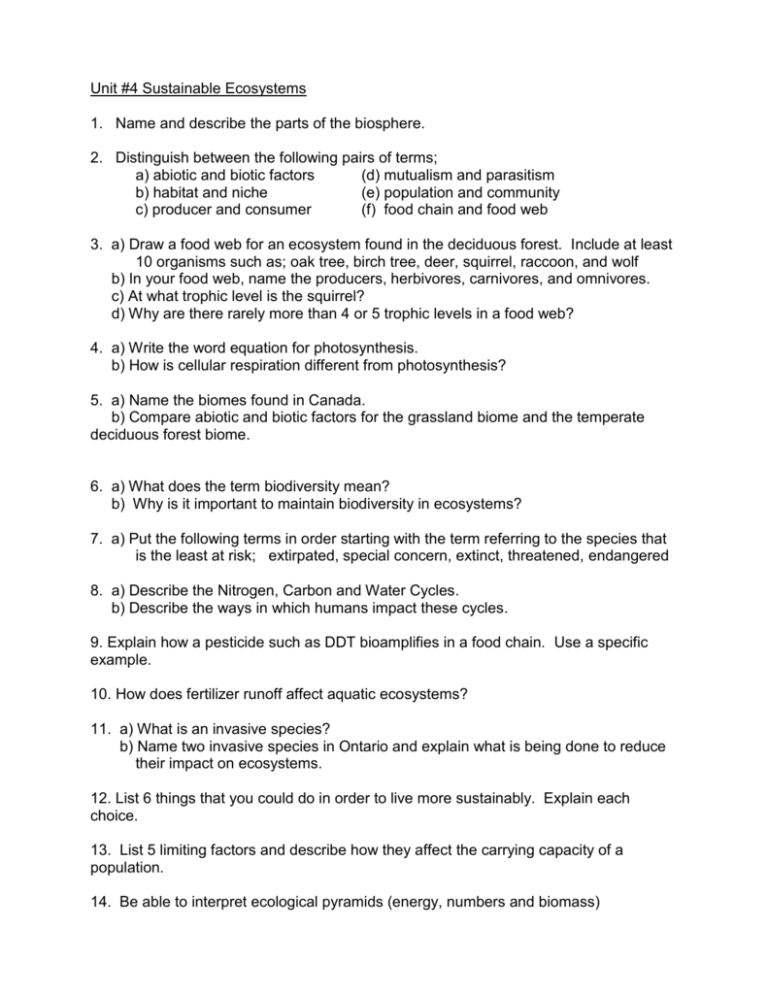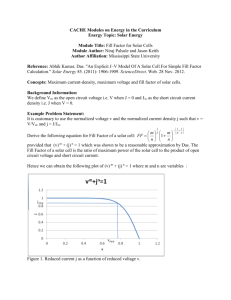REVIEW for Science Exam 1D
advertisement

Unit #4 Sustainable Ecosystems 1. Name and describe the parts of the biosphere. 2. Distinguish between the following pairs of terms; a) abiotic and biotic factors (d) mutualism and parasitism b) habitat and niche (e) population and community c) producer and consumer (f) food chain and food web 3. a) Draw a food web for an ecosystem found in the deciduous forest. Include at least 10 organisms such as; oak tree, birch tree, deer, squirrel, raccoon, and wolf b) In your food web, name the producers, herbivores, carnivores, and omnivores. c) At what trophic level is the squirrel? d) Why are there rarely more than 4 or 5 trophic levels in a food web? 4. a) Write the word equation for photosynthesis. b) How is cellular respiration different from photosynthesis? 5. a) Name the biomes found in Canada. b) Compare abiotic and biotic factors for the grassland biome and the temperate deciduous forest biome. 6. a) What does the term biodiversity mean? b) Why is it important to maintain biodiversity in ecosystems? 7. a) Put the following terms in order starting with the term referring to the species that is the least at risk; extirpated, special concern, extinct, threatened, endangered 8. a) Describe the Nitrogen, Carbon and Water Cycles. b) Describe the ways in which humans impact these cycles. 9. Explain how a pesticide such as DDT bioamplifies in a food chain. Use a specific example. 10. How does fertilizer runoff affect aquatic ecosystems? 11. a) What is an invasive species? b) Name two invasive species in Ontario and explain what is being done to reduce their impact on ecosystems. 12. List 6 things that you could do in order to live more sustainably. Explain each choice. 13. List 5 limiting factors and describe how they affect the carrying capacity of a population. 14. Be able to interpret ecological pyramids (energy, numbers and biomass) REVIEW for Grade Nine Academic Science Exam Unit #3 Space 1. a) Draw and label a diagram showing the different layers of the Sun. b) Distinguish between solar flares, solar prominences and sunspots. c) What reaction powers the Sun? 2. a) Name the planets in our Solar System and describe some of their unique characteristics. b) Why is Pluto no longer considered a planet? What is it classified as now? c) Distinguish between a meteor, a meteorite and a meteoroid. d) What is an asteroid? Give an example of one. e) What is a comet? Give an example of one. 3. Distinguish between the following pairs of terms: a) astronomical unit and light year b) rotation and revolution c) geocentric and heliocentric models of the solar system d) equinox and solstice e) lunar eclipse and solar eclipse 4. a) What is a constellation? Name three. b) Describe how to locate Polaris or Sirius using pointer stars. 5. a) How are star colour and star temperature related? b) How are star size and star life span related? 6. Compare the life cycle of small-medium stars, large stars and extremely large stars using the terms nebula, nuclear fusion, red giant or supergiant, white dwarf, supernova, neutron star, and black hole. 7. Describe the Big Bang theory. 8. Describe the Moon in terms of its surface features, its gravity compared to Earth’s, its atmosphere, its origin and its phases. 9. a) Why do we experience the seasons in Canada? Explain by making reference to the tilt of Earth’s axis. 10. How do planets stay in stable orbits around the Sun? 11. Be prepared to describe the Opollo 13 mission, its goals, problems and solutions. Unit #1 – Chemistry 1. State the main points of the particle theory of matter. 2. a) Draw a concept map to show how matter is classified. Include the following; pure substance, mixture, solution (homogeneous mixture), mechanical mixture (heterogeneous mixture), element and compound. b) Define each of the above terms and give an example of each. 3. Distinguish between the following terms; a) physical property and chemical property b) quantitative physical property and qualitative physical property c) physical change and chemical change d) metals and non-metals 4. Describe the following physical properties for the following objects: a) ductility of copper wire (b) malleability of aluminum foil c) viscosity of molasses (d) clarity of a desk? a window? e) brittleness of glass (f) colour of water? the science hall at TAS? g) lustre of gold (h) state of ice? 5. Give 5 clues that a chemical change may have occurred. 6. Classify each of the following as a physical change or a chemical change: a) wood is sawed and made into a toy box. (d) water boils and turns into steam b) firewood burns and ashes remain. (e) garbage rotting c) orange drink crystals are stirred into a pitcher of water 7. a) What is a characteristic physical property? Give an example of one. b) Calculate the density of an object having a mass of 5.4 grams and a volume of 2.0 cm3. Water has a density of 1 g/mL. Will this object float or sink in water? c) A sample of pure iron (with a density of 7.87 g/cm3) has a mass of 5.0 g. Calculate its volume. 8. Briefly describe the contributions of the following scientists to the model of the atom; a) Dalton (b) Thomson (c) Rutherford (d) Chadwick (e) Bohr 9. Draw a Bohr-Rutherford diagram for an atom with the atomic number of 13 and a mass number of 27. 10. For the molecule: NaHCO3 a) Name the elements and state the number of atoms of each element b) Is this molecule an element or a compound? Explain your reasoning. 11. Name the gas that would; a) extinguish a burning splint and turn limewater cloudy b) make a popping sound when a burning splint is inserted into it c) cause a glowing splint to burst into flames 12. Describe the properties of the following groups of the periodic table; a) noble gases (b) alkali metals (c) alkaline earth metals d) halogens Unit #2 - Electricity 1. What is the charge of the following particles: a) proton? (b) neutron? (c) electron? 2. What is the overall charge on the object on the right? 3. State the laws of electric charges. 4. a) Explain charging by friction. b) Using the electrostatic series, predict the overall charges on a cotton shirt after it has been rubbed by a wool sweater. Explain which charges move and in which direction 5. a) Explain charging by conduction. b) Draw a diagram to show what happens when a positively charged rod touches a neutral pith ball. What charge will the pith ball acquire? Which charges move and in which direction? 6. a) Explain charging by induction. b) If you rub a balloon on your head, the balloon will acquire a negative charge. If you then approach a wall with the balloon, what charge will be induced at the wall’s surface? Explain why. c) A metal leaf electroscope can be given a permanent positive charge by induction. Explain how. 7. Distinguish between the following pairs of terms; a) insulators and conductors b) AC and DC c) series and parallel circuits 8. Give an example of the following parts of an electric circuit; a) load (b) source (c) conductors (d) control 9. a) Explain the meaning of current. b) What is the symbol for current? What is the symbol for the unit for current? c) What happens to the current at the source in a parallel circuit when more loads are added? d) In a series circuit with two lamps, if the current at the source is 0.6 A, what is the current through lamp 2? 10. a) Explain the meaning of potential difference (voltage). b) What is the symbol for voltage? What is the symbol for the unit for voltage? c) In a parallel circuit with two lamps, what is the relationship between the voltage across the source and the voltage across the lamps? d) In a series circuit with two identical lamps, if the voltage across the source is 12 V, what is the voltage across lamp 1? 11. a) Explain the meaning of resistance. b) A blender has a 35 Ω resistor that has a 5.0 A of current going through it. What is the potential difference (voltage) across the resistor? 12. a) Name some renewable methods of generating electricity. b) What are some pros and cons of nuclear generation of electricity. 13. Calculate the cost of operating a 400W computer for 600 hours at 12 cents/kWh.





